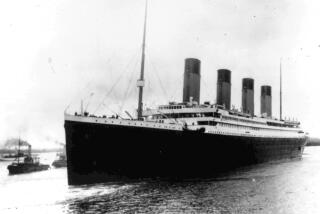Controversy Revived Over Ship That Failed to Aid Liner : Titanic Victims ‘Died Needlessly,’ Scientist Says
- Share via
WASHINGTON — Reopening a 73-year-old controversy, the scientist who led the expedition that found the sunken liner Titanic said Wednesday that the 1,500 persons who drowned in the 1912 maritime disaster “died needlessly” because a passenger ship was near enough to rescue them.
“There is no doubt in my mind that those people could have been rescued; they could have been saved,” said Robert D. Ballard, chief American scientist on the joint French-American expedition that found the wreck of the Titanic early Sept. 1 under 13,000 feet of water off the Grand Banks of Newfoundland. “They died needlessly.”
Ballard told a crowded news conference that the Californian, a 47-passenger ship en route from London to Boston, was “inside 10 miles, maybe five” when the huge Titanic hit an iceberg on its maiden transatlantic voyage and sank on the calm, moonless night of April 14, 1912.
The role of the Californian has long been disputed. Crew members on the 6,000-ton Leyland Liner testified later that they were close enough to see the Titanic shoot eight emergency white rockets high in the air but that Capt. Stanley Lord did not respond to the international distress signal.
Drifting Ice Cited
Lord maintained during two British Board of Trade inquiries and a U.S. Senate investigation that his ship was blocked by drifting ice nearly 20 miles away, too far away to see or help the stricken Titanic. Lord, who said relevant parts of his ship’s log had been lost, was fired from his company but was not prosecuted.
Ballard said Wednesday that Lord had a “vested interest” and did not report his position correctly. Ballard said he and his colleagues from the French Institute for Research and Exploration of the Sea had found the Titanic by studying logs of the Cunard liner Carpathia and other rescue ships that arrived hours later.
Only about 700 persons survived the sinking. The 45,000-ton Titanic, the largest and most luxurious liner of its time, carried enough lifeboats and rafts for only 1,178 of the 2,207 persons on board, and many lifeboats rowed away half empty.
Charles A. Haas, president of the 2,300-member Titanic Historical Society, said he was not convinced by Ballard’s rehashing of the Californian debate. He speculated that another ship might have blocked the Californian’s view. Lord died in 1962, Haas said.
Ballard described his long-planned search in detail Wednesday for the first time, using several dozen black and white undersea slides and videotapes at a lengthy news conference at the National Geographic Society, which contributed equipment and personnel to the expedition.
The photos showed such details as a silver serving platter, scattered bottles of wine and rivets on a boiler head. Also visible were broken and twisted steel cranes, a gaping hole where the first smokestack had fallen into a group of passengers and a broken skylight above what Ballard said was the first-class smoking room, grand ballroom and gymnasium.
“It was the most beautiful part of the Titanic,” he said, pointing to a hazy black and white image. “You can see right down the grand staircase.”
Navy Secretary John F. Lehman Jr. congratulated Ballard and his colleagues on their successful development and use of deep-sea television and sonar equipment. The Navy paid the bulk of the expedition’s cost under a $2.8-million research and development contract with the Woods Hole Oceanographic Institution in Massachusetts, where Ballard, 43, is an oceanographic geologist.
Despite the “tremendous high technology, the best of both countries,” Ballard said, it was the 25-year-old sonar on the Knorr, the mother research ship, that first pinpointed the wreck 2 1/2 miles below. “You could have done it with a fishing boat,” he said with a laugh.
Ballard refused to provide details of the Titanic’s location, saying that he was trying to protect the wreck from salvors.
Rep. Walter B. Jones (D-N. C.), chairman of the House Merchant Marine and Fisheries Committee, introduced a bill Wednesday to protect the site by designating the wreck a maritime memorial.
More to Read
Sign up for Essential California
The most important California stories and recommendations in your inbox every morning.
You may occasionally receive promotional content from the Los Angeles Times.











